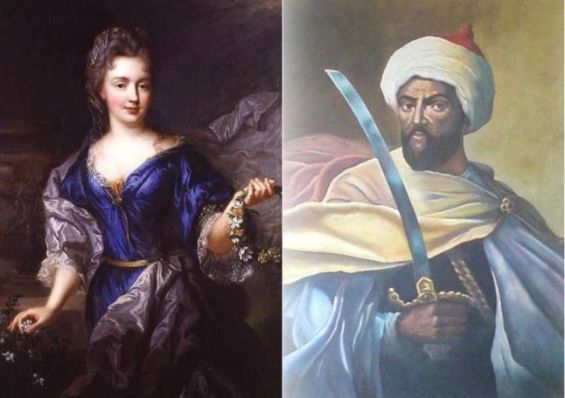Few stories in Moroccan-French diplomatic history have captured the imagination quite like the alleged marriage proposal of Sultan Moulay Ismail to the daughter of King Louis XIV of France. This intriguing episode, set against the backdrop of 17th-century geopolitics, has been the subject of both historical scrutiny and romantic speculation.
Moulay Ismail, who ruled Morocco from 1672 to 1727, was a contemporary of Louis XIV, the Sun King of France. In 1698, after 22 years on the throne, Moulay Ismail dispatched his ambassador, Abdellah Benaïcha, to Versailles. Benaïcha, a former corsair turned diplomat, was tasked with negotiating a treaty between the two nations.
 Sultan moulay Ismail of Morocco. / Ph. DR
Sultan moulay Ismail of Morocco. / Ph. DR
The Ball at Château de Saint-Cloud
During his stay in France, Benaïcha attended a ball at the Château de Saint-Cloud, hosted by Philippe d'Orléans, the brother of King Louis XIV. It was here that he first laid eyes on Marie-Anne de Bourbon, the Princess of Conti, who was the legitimized daughter of Louis XIV and his favorite, Louise de La Vallière.
Historian Michel de Decker, in the France 2 program «Secrets d'Histoire» describes Marie-Anne as a captivating figure: «She was fine, she was svelte, she was slender, she danced admirably, she had a look... The whole court was in turmoil as soon as she appeared». The 32-year-old widow, also known as Mademoiselle de Blois, left a lasting impression on the Moroccan ambassador.
According to historian Clémentine Portier-Kaltenbach, Benaïcha «nourished this mad dream of seeing his sultan marry the daughter of the Emperor of Europe, the Emperor of the French, Louis XIV». The ambassador's admiration for the princess was not personal but rather fueled by diplomatic ambition.
Upon his return to Morocco, Benaïcha regaled Sultan Moulay Ismail with tales of the princess's beauty and grace. Intrigued by the prospect of a strategic alliance with France, the Sultan decided to pursue the matter further. Despite already having a substantial harem—reportedly 500 concubines who had borne him around 1,000 children—Moulay Ismail saw potential political advantages in such a union.
 Moroccan Ambassador to France Abdullah Ben Aicha. / Ph. DR
Moroccan Ambassador to France Abdullah Ben Aicha. / Ph. DR
The proposal : Historical accounts
The Moroccan historian Abd al-Rahman ibn Zaydan, in his book «المنزع اللطيف في مفاخر المولى إسماعيل بن الشريف» (The Delicate Path in the Glories of Moulay Ismail ibn Sharif), provides insight into this diplomatic overture. According to ibn Zaydan, Moulay Ismail instructed Benaïcha to present a marriage proposal to Louis XIV on his behalf.
As recounted by ibn Zaydan, the proposal was conveyed in a letter that Benaïcha dictated in Spanish and had translated into French. The letter, dated November 14, 1699, stated: «Our lord the Sultan has ordered me that if the King of France's answer is in accordance with what is contained in this letter of ours, I should set out on any French ship arriving at the port of Salé or elsewhere, to proceed to the presence of His Majesty, that august King».
The letter continued, expressing Moulay Ismail's desire «to enter into an alliance with the most esteemed and greatest of kings, and to allow him entry into all the ports of the Sherifian Empire (Morocco) and all its cities and regions, as well as to all his subjects».

Conflicting historical interpretations
However, the veracity of this proposal and its reception in the French court have been subjects of debate among historians. Some, like the French historian Victor Piquet in his book «Le Maroc : géographie, histoire, mise en valeur» suggest that the offer was met with derision and indignation, prompting Louis XIV to respond by inviting Moulay Ismail to convert to Christianity.
On the other hand, Abd al-Rahman ibn Zaydan presents a more nuanced view. He cites French historians close to Louis XIV who claim that the French king was compelled to decline politely, citing cultural differences as the official reason. Privately, however, Louis XIV reportedly expressed concerns about Moulay Ismail's polygamous practices and rumors of his severity and strong personality.
The story gained such notoriety in French royal and elite circles that it inspired the French poet Jean-Baptiste Rousseau to compose verses for the French princess, saying: «Your beauty, O great princess, carries the marks of a love whose wound reaches the wildest places. Africa has surrendered to you... and the conquests of your eyes have surpassed what Hercules achieved».
Despite its romantic appeal, some Moroccan historians have cast doubt on the authenticity of this marriage proposal. Abdelkarim Ghallab, in his book «قراءة جديدة في تاريخ المغرب العربي: عهد الإمبراطورية» (A New Reading in the History of the Arab Maghreb: The Era of the Empiredismisses) dismisses the event as a myth attributed to history. Abd al-Rahman ibn Zaydan, while not outright denying the incident, expresses skepticism about its occurrence.
Abdelhadi Tazi, in his book «التاريخ الدبلوماسي للمغرب الأقصى: من أقدم العصور إلى اليوم» (The Diplomatic History of Morocco: From Ancient Times to Today) offers an alternative interpretation. He suggests that the marriage proposal might have been a diplomatic maneuver aimed at improving relations with France, which were reportedly on the brink of severance at the time.
Regardless of its historical accuracy, the tale has left its mark on popular culture. Two and a half centuries later, it inspired the writer Anne Golon for one of the adventures of her heroine Angélique, Marquise des Anges, immortalized in cinema by Michèle Mercier. One of the films in this cult series from the 1960s, frequently rebroadcast on French television, is titled Angélique and the Sultan.
Moroccan diplomacy in the 17th and 18th centuries
The story also speaks to the broader context of Moroccan-European diplomacy in the 17th and 18th centuries. The Moroccan historian Abdullah Farid al-Wajdi, in his encyclopedic work, provides valuable insights into the diplomatic capabilities of Morocco during this period. He describes numerous instances of Moroccan envoys demonstrating proficiency in foreign languages and diplomatic protocols, challenging the notion that Moroccan diplomacy was inferior to that of its European counterparts.
One such example is the Moroccan embassy to Queen Victoria of England in 1860. The detailed account of this diplomatic mission, as recorded by Mohammed Tahar al-Fassi, reveals the high regard in which Moroccan diplomats were held. The Queen reportedly stood to greet the Moroccan delegation, expressing joy at their arrival and inquiring about the well-being of their sultan.
Fact, fiction, or diplomatic strategy?
In the mausoleum of Sultan Moulay Ismail in Meknes, four Comtoise clocks stand as silent witnesses to this historical episode. Legend has it that these were gifts from the Sun King, Louis XIV, as compensation for refusing to grant the hand of the beautiful Marie-Anne to the Moroccan sultan.
While the truth behind Moulay Ismail's proposal may never be definitively established, the story continues to fascinate historians and the public alike. It serves as a reminder of the complex interplay between diplomacy, culture, and personal ambition that has long characterized international relations.
 The Mausoleum of Sultan Moulay Ismail in Meknes: Two wooden clocks that are said to be a gift from King Louis XIV to Sultan Moulay Ismail as an apology for rejecting the marriage proposal of his daughter Marie
The Mausoleum of Sultan Moulay Ismail in Meknes: Two wooden clocks that are said to be a gift from King Louis XIV to Sultan Moulay Ismail as an apology for rejecting the marriage proposal of his daughter Marie
As we reflect on this curious tale, we are reminded of the words of moroccan historian Abdelhadi Tazi, who suggests that the entire episode may have been a clever diplomatic ploy. In the intricate dance of 17th-century geopolitics, perhaps the true significance of this story lies not in its literal truth, but in what it reveals about the diplomatic strategies and cultural perceptions of the time.
The saga of Moulay Ismail and the Princess of Conti, whether historical fact or diplomatic fiction, remains a captivating chapter in the long and complex history of Moroccan-French relations. It continues to inspire debate, research, and imagination, underscoring the enduring fascination with the intersection of power, politics, and romance in the annals of history.





 chargement...
chargement...













